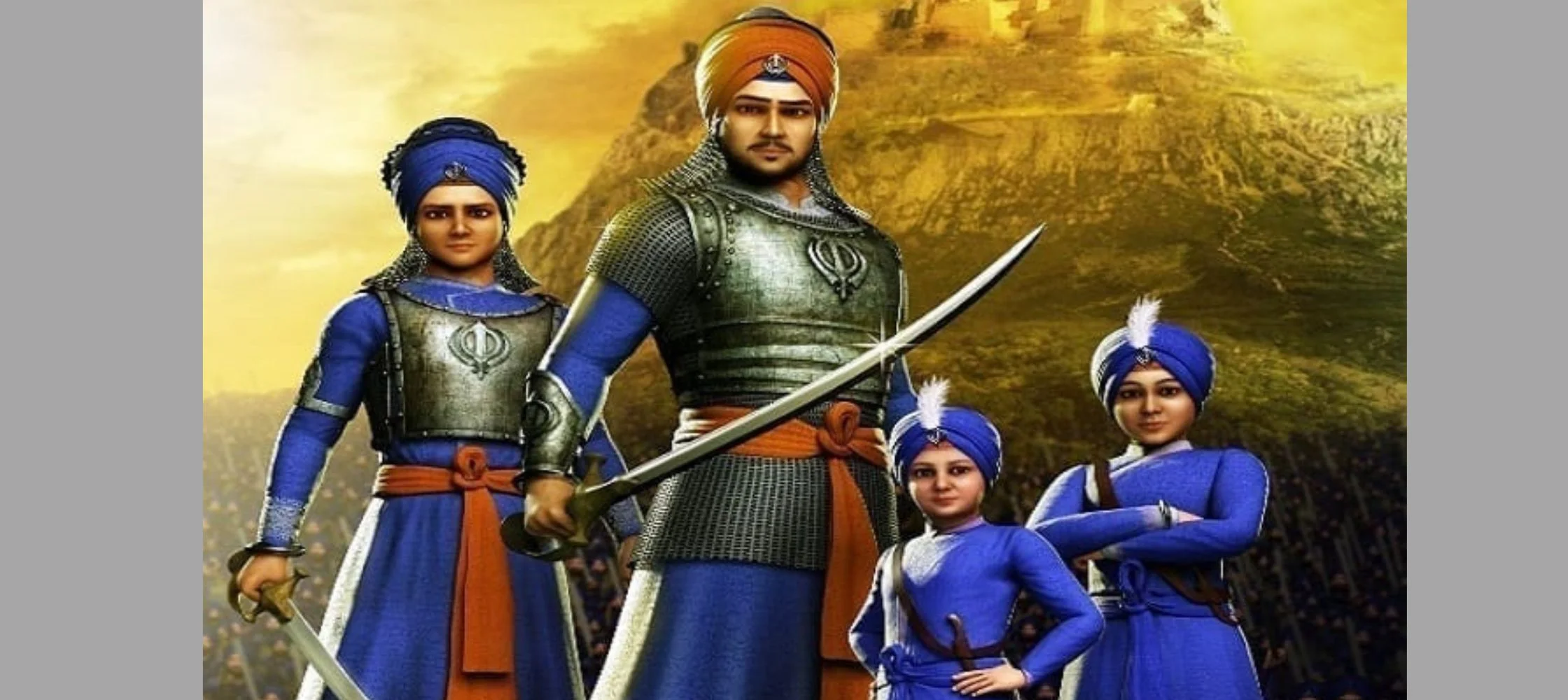
December is the month of the year to send warm wishes to family and friends and celebrate Christmas. However, for Sikhs, it is the month to remember the sacrifices made by the ‘Chaar Sahbizaade’ of Guru Gobind Singh. The fearlessness and courage of Sikhs is demonstrated throughout history. The incident that took place in December 1704 holds a very significant place in the hearts of the Sikh community. The word ‘Chaar’ means four and ‘Sahibzaade’ means sons.
Guru Gobind Singh ji is the 10th guru of Sikhs. He had four sons popularly known as “Chaar Sahibzaade” namely Ajit Singh Ji (18 years old), Jujhar Singh Ji (14 years old), Zorawar Singh Ji (9 years old) and Fateh Singh Ji (7 years old). According to Sikh tradition, Fateh Singh was the first Nihang warrior and inspired the traditions of the Nihang sect.
Baba Zorwar Singh ji and Baba Fateh Singh Ji, the youngest of the Chaar Sahibzade were ordered by Wazir Khan, the Nawab of Sirhind to be bricked alive because they refused to convert from Sikhism to Islam. This sad and horrific event took place on 26th December 1704. Before the two Sahibzade were bricked alive, they were captured in a cold tower called “Thanda Burj” with their grandmother Mata Gujari, amidst cold winter.
The martyrdom of the Chaar Sahibzaade is one of the most important and integral parts of Sikh history. This occasion of their martyrdom is remembered and commemorated both with great dynamism and sadness by the entire Sikh community worldwide. The month of December is also known as the month of “Poh”.
Every year on 24-26 December, Saheedi Jor Mela also known as Shaeedi Jor Mel/Sabha is organized at Fatehgarh Sahib, Punjab, India to commemorate the grave sacrifice at the place of the martyrdom of Chotte Sahibzade- the younger two sons of Guru Gobind Singh Ji.
On a chilly cold night of December 20th, 1704 AD, Guru Gobind Singh ji, his wife and four sons along with Panj Piaras and hundreds of Sikhs left Anandpur Sahib after the Pahaadi King and the Mughal promised that they would not attack the fort. But as soon as Guru Gobind Singh Ji left the fort, Mughals breached the vows and attacked Sikhs at the Sarsa River about 25 km away from Anandpur Sahib. Because of this attack, the entire family got separated. The spot where they all got separated is known as “Pariwar Vichora”. A gurdwara was built in this memory known as “Gurdwara Pariwar Vichora Sahib”.
Guru Gobind Singh Ji’s mother, Mata Gujri ji and Chhotte Sahibzaade- Zorawar Singh ji and Fateh Singh ji, were on one side of the river while Guru Gobind Singh ji and the elder two sons were on the other side of the river. Mata Sundri ji and Mata Sahib Kaur ji went to Delhi with Bhai Mani Singh ji.
From there, Guru Gobind Singh ji, Vadde Sahibzade, Panj piaras and 40 Sikhs proceeded towards Chamkaur and fought the famous battle of Chamkaur Sahib against the Mughal governor of Sirhind, Wazir Khan. Wazir Khan is well-known for ordering the execution of Guru Gobind Singh Ji’s younger two sons in 1704. The Mughal army was well-equipped and the elder two sons of Guru ji, three Panj Piaras and 40 Sikhs attained martyrdom.
On the other hand, other Sikhs were also martyred and Chhotte Sahibzaade was left with Mata Gujri ji. A servant, Gangoo, saw them and offered to keep them in his house but later breached their trust by disclosing their location to the Mughals. All three of them were captured by the Mughals and kept in an open tower during the winter of December month. All three were imprisoned in the Open Tower known as “Thanda Burj” with no mats to sleep on. The sons were brought to Wazir Khan who believed in Emperor Aurangzeb’s vision. He told the Sahibzaade that he would spare their lives if they agreed to convert to Islam. Wazir khan was however defeated and beheaded by a Sikh named Fateh Singh during the battle of Chappar Chiri on 22 May 1710.
At such a young age, the two Sahibzaade refused to convert their religion and stood steadfast and loyal to the Khalsa Panth. This angered Wazir Khan and he ordered that a brick wall be put up around them. The two Sahibzaade were bricked alive. Mata Gujari Kaur could not bear the trauma and on the same day left for her heavenly abode.
This heinous crime was committed in the Sarzameen of Sirhind and now this place is known as “Jyoti Swaroop Gurdwara Sahib” at Fatehgarh Sahib in Punjab.
Your email address will not be published. Required fields are marked *
29 Jan, 2024
29 Jan, 2024
29 Jan, 2024
25 Jan, 2024